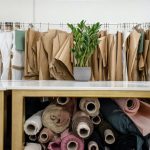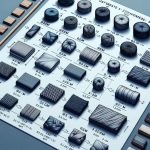To test the quality of a nonwoven fabric, you’ll start with a close visual inspection for surface defects like holes or uneven bonding. Measure the fabric’s weight and thickness to assess density and durability. Check tensile strength using strip or grab tests, and evaluate water resistance with spray or hydrostatic pressure tests. Also, test air permeability for breathability and analyze chemical composition for safety. Keep these steps in mind to better understand fabric performance and guarantee top quality.
Table of Contents
Key Takeaways
- Inspect fabric visually under good lighting for defects like holes, fiber clumps, and color inconsistencies across the surface.
- Measure fabric weight (GSM) and thickness with precise tools to assess density, durability, and breathability.
- Test tensile strength using strip, grab, or ball burst tests to evaluate durability under stress.
- Assess water resistance through hydrostatic pressure and spray tests, observing water repellency and absorbency behavior.
- Evaluate air permeability and thermal properties by measuring airflow rates and heat resistance for comfort and bonding quality.
Understanding the Basics of Nonwoven Fabric Quality
Although nonwoven fabrics might seem simple at first glance, their quality depends on several critical factors you need to understand.
You should focus on fiber type, bonding method, and fabric weight, as these directly impact durability and performance. Different fibers like polyester or polypropylene offer varying strength and softness, so choose based on your application.
The bonding process—whether thermal, chemical, or mechanical—affects how well the fibers hold together under stress. Additionally, fabric weight, measured in grams per square meter (gsm), indicates thickness and density, influencing absorbency and filtration.
Visual Inspection for Surface Defects and Uniformity
Once you understand the key factors that influence nonwoven fabric quality, the next step is to inspect the fabric visually for surface defects and uniformity.
Carefully examine the fabric under good lighting, looking for inconsistencies like holes, thin spots, or contaminants. Check for any clumps of fibers or uneven bonding, which can compromise strength and appearance.
Inspect fabric closely under good light for holes, thin spots, contaminants, fiber clumps, or uneven bonding.
Uniformity is essential; verify the texture and color remain consistent across the entire fabric width and length. Don’t overlook edges, as they often reveal production issues.
You can use a magnifying glass for a closer look, but your naked eye is usually sufficient. By spotting these defects early, you prevent inferior products from moving forward, maintaining high-quality standards throughout your process.
Measuring Fabric Weight and Thickness
When you measure fabric weight, or GSM, you get a key indicator of the material’s density and quality.
Using precise tools to gauge thickness helps you understand how the fabric will perform in real-world applications.
These measurements directly impact durability, comfort, and overall functionality.
Importance of GSM
Understanding GSM (grams per square meter) is vital because it directly affects the performance and durability of nonwoven fabrics.
When you measure GSM, you’re quantifying the fabric’s weight per unit area, which helps determine its strength, thickness, and suitability for specific applications. A higher GSM typically means a denser, more durable fabric, ideal for heavy-duty uses, while a lower GSM indicates lighter, more breathable materials suited for disposable or delicate products.
By knowing the GSM, you can guarantee the fabric meets your quality standards and functional requirements. It also helps in comparing different batches or suppliers to maintain consistency.
Thickness Measurement Tools
Several precise tools help you measure the thickness of nonwoven fabrics, ensuring you get accurate data alongside the fabric’s weight. You can use digital micrometers for quick, reliable readings or manual thickness gauges for more controlled measurements. Ultrasonic thickness gauges offer non-contact options, ideal when you want to avoid fabric compression. Each tool suits different testing needs, so choosing the right one is key.
| Tool Type | Measurement Range | Best For |
|---|---|---|
| Digital Micrometer | 0-25 mm | Quick, precise measurements |
| Manual Thickness Gauge | Up to 10 mm | Controlled, consistent readings |
| Ultrasonic Gauge | Variable, non-contact | Delicate or compressible fabrics |
Using these tools, you’ll get consistent thickness data to complement your fabric’s GSM for thorough quality testing.
Impact on Fabric Performance
Although fabric weight and thickness might seem like simple measurements, they directly influence the performance characteristics of nonwoven fabrics.
When you measure these properties accurately, you can predict how the fabric will behave in real-world applications. Heavier fabrics typically offer better durability and barrier properties, while thinner ones provide flexibility and breathability.
Thickness affects cushioning, filtration efficiency, and insulation. If you skip these measurements, you risk using a fabric that won’t meet your product’s needs.
By understanding the weight and thickness, you can select or engineer nonwoven fabrics that perform reliably under stress, moisture, or wear.
Tensile Strength Testing Methods
Measuring the tensile strength of nonwoven fabric lets you assess its durability and performance under stress. You typically use methods like the strip test, grab test, and the universal testing machine (UTM) to understand how much force the fabric can withstand before breaking.
| Method | Description |
|---|---|
| Strip Test | Measures strength along a narrow strip |
| Grab Test | Tests a larger fabric area for practical use |
| Universal Testing | Uses precise machines for accurate results |
| Ball Burst Test | Applies force evenly to mimic real-world usage |
Each method provides specific insights, so choose based on your fabric’s application. By testing tensile strength, you guarantee your nonwoven fabric meets required standards for its intended use.
Assessing Tear Resistance of Nonwoven Fabrics
To evaluate how well your nonwoven fabric withstands tearing forces, you need reliable tear resistance tests.
These tests help determine the fabric’s durability and suitability for various applications. Here’s how you assess tear resistance effectively:
These tests reveal the fabric’s durability and ensure it meets application requirements effectively.
- Choose the right test method – Common methods include the Elmendorf and Trouser tear tests, each suited for different fabric types and thicknesses.
- Prepare consistent samples – Cut fabric samples uniformly to guarantee accurate, comparable results.
- Perform the test under controlled conditions – Maintain standard temperature and humidity to avoid variations in fabric behavior.
- Record tear force accurately – Use a calibrated testing machine to measure the force required to propagate a tear.
Following these steps guarantees you get precise data on your fabric’s tear resistance, helping you make informed quality decisions.
Evaluating Water Resistance and Absorbency
Now that you’ve checked tear resistance, it’s time to evaluate how well your nonwoven fabric handles water.
You’ll want to test water resistance using methods like spray or hydrostatic pressure tests.
At the same time, measuring how much water the fabric absorbs helps you understand its performance in different applications.
Water Resistance Testing Methods
Although water resistance is a critical factor for many nonwoven fabrics, determining how well a material repels or absorbs moisture requires specific testing methods.
You need reliable procedures to assess performance accurately. Here are four common water resistance testing methods you can use:
- Hydrostatic Pressure Test – Measures the pressure water exerts before it penetrates the fabric.
- Spray Test – Simulates rain by spraying water on the fabric and evaluating surface wetness.
- Water Repellency Test – Uses water droplets to assess how quickly they bead up and roll off.
- Impact Penetration Test – Drops water onto the fabric from a fixed height to check for penetration under impact.
These tests give you clear insights into how water-resistant your nonwoven fabric is under various conditions.
Measuring Fabric Absorbency
Understanding how water interacts with nonwoven fabrics doesn’t stop at resistance—you also need to measure absorbency to get the full picture. To evaluate absorbency, you can perform tests like drop absorbency, where you time how quickly water penetrates the fabric. Another method involves soaking the fabric and measuring the amount of water absorbed by weight difference. These tests help determine suitability for applications like hygiene products or medical dressings.
| Test Method | What It Measures |
|---|---|
| Drop Absorbency | Time for water absorption |
| Soak Test | Water volume absorbed |
| Wicking Test | Capillary water movement |
| Absorption Rate | Speed of water uptake |
| Retention Capacity | Total water held by fabric |
Use these results to assess fabric performance effectively.
Air Permeability Testing Procedures
Since air permeability directly affects a nonwoven fabric’s breathability and comfort, you’ll want to follow precise testing procedures to measure it accurately.
Accurate air permeability testing is essential for assessing nonwoven fabric breathability and comfort.
Start by conditioning your fabric samples in a controlled environment, typically at 21°C and 65% humidity, to guarantee consistent results. Then, mount the sample securely on the testing instrument, making sure there are no leaks around the edges.
Next, set the airflow rate according to the relevant standard, like ASTM D737, and initiate the test. Finally, record the airflow passing through the fabric per unit area and calculate the permeability value.
- Condition samples under standard temperature and humidity
- Mount fabric securely on the air permeability tester
- Set airflow rate per testing standard
- Measure and record airflow to calculate permeability
Following these steps guarantees reliable, repeatable measurements.
Thermal Bonding and Heat Resistance Evaluation
When you evaluate thermal bonding and heat resistance, you assess how well the fibers in a nonwoven fabric fuse together under heat and how the fabric withstands high temperatures.
Start by examining the bonding strength using a peel or tensile test; a stronger bond indicates better thermal fusion.
Then, test heat resistance by exposing the fabric to controlled high temperatures for a set time, observing any deformation, melting, or loss of integrity.
You can also use differential scanning calorimetry (DSC) to measure melting points and thermal changes, helping you understand the fabric’s behavior under heat.
Ensuring proper thermal bonding and heat resistance guarantees durability and performance in applications where temperature exposure is common.
Always document your results thoroughly for consistent quality control.
Chemical Composition and Contaminant Analysis
Although nonwoven fabrics often look uniform, their chemical composition can vary considerably, affecting performance and safety.
To guarantee you’re getting high-quality material, you need to analyze the fabric’s chemical makeup and check for contaminants. Here’s how you can approach it:
- Use Fourier Transform Infrared Spectroscopy (FTIR) to identify polymer types and additives.
- Perform gas chromatography-mass spectrometry (GC-MS) to detect residual solvents or harmful chemicals.
- Conduct pH testing to guarantee the fabric is neutral and won’t irritate skin.
- Test for heavy metals and other toxic substances using atomic absorption spectroscopy (AAS).
Frequently Asked Questions
How Does Nonwoven Fabric Recycling Impact Environmental Sustainability?
You reduce waste, conserve resources, and cut emissions when you recycle nonwoven fabric. You support environmental sustainability by turning old materials into new products, minimizing landfill impact, and promoting a circular economy that benefits the planet.
What Are the Common Applications of Nonwoven Fabrics in Healthcare?
You’ll find nonwoven fabrics used in healthcare for surgical gowns, masks, wound dressings, and sterilization wraps. They’re lightweight, breathable, and disposable, making them perfect for infection control and patient safety in medical environments.
How Do Manufacturing Techniques Affect Nonwoven Fabric Softness?
Oh, because you absolutely want your nonwoven fabric to feel like a cloud hugged it—manufacturing techniques like fiber bonding and calendaring directly affect softness. You’ll find gentler processes yield softer, more comfortable fabrics for your skin.
What Are the Cost Differences Between Spunbond and Meltblown Fabrics?
You’ll find spunbond fabrics usually cost less than meltblown ones because spunbond uses simpler processes and cheaper raw materials. Meltblown fabrics, with finer fibers and higher filtration efficiency, tend to be pricier due to complex production.
How Can Consumers Differentiate Between Branded and Generic Nonwoven Products?
You can spot branded nonwoven products by checking labels, certifications, and packaging quality. Branded items often have consistent texture and durability, while generic ones might vary. Reviews and trusted retailers help you make smarter choices.
- What Is PET Spunbond Nonwoven Fabric? - July 11, 2025
- How to Test the Quality of a Nonwoven Fabric - July 11, 2025
- The Benefits of Using Nonwoven Wallpaper in Your Home - July 11, 2025







